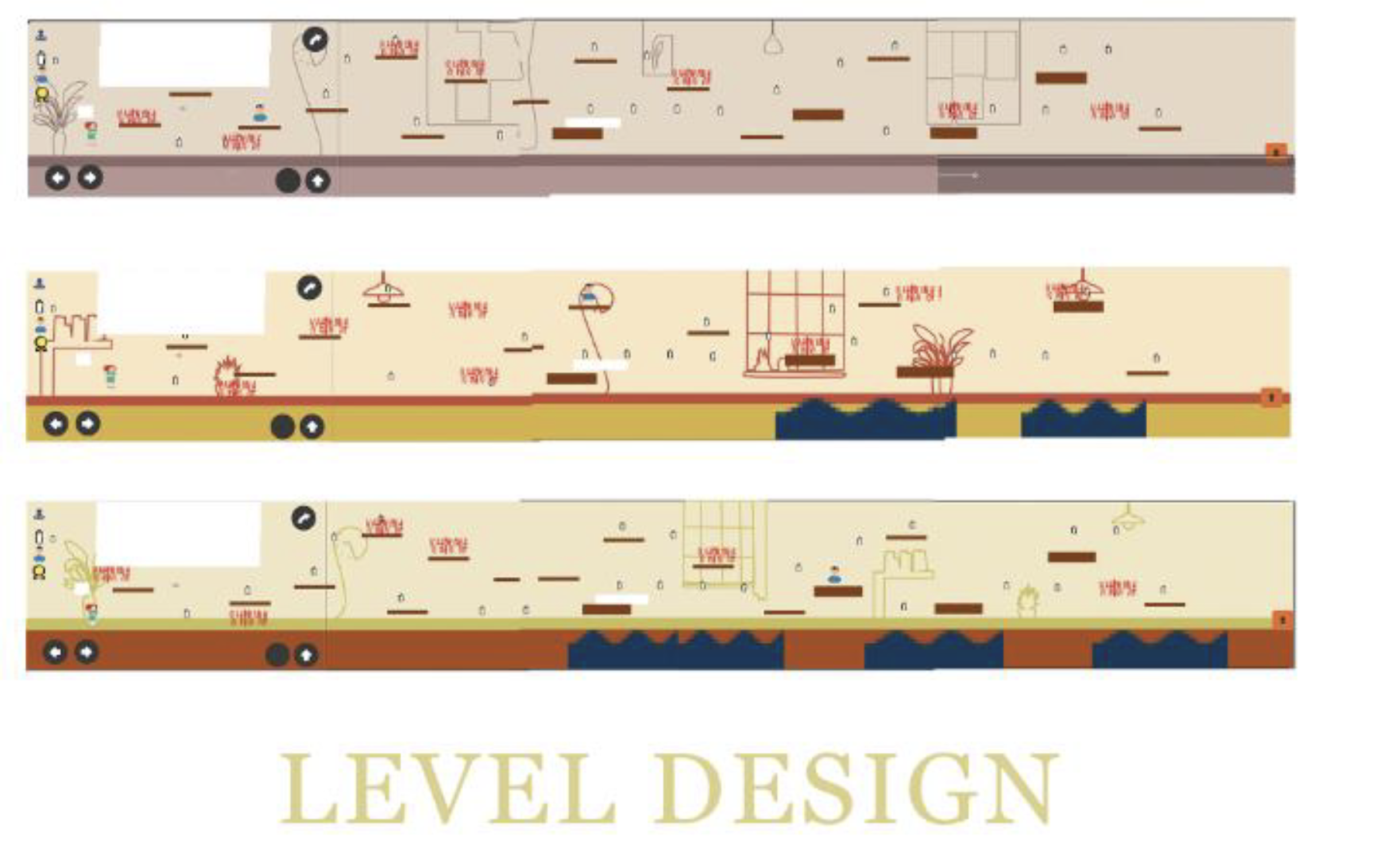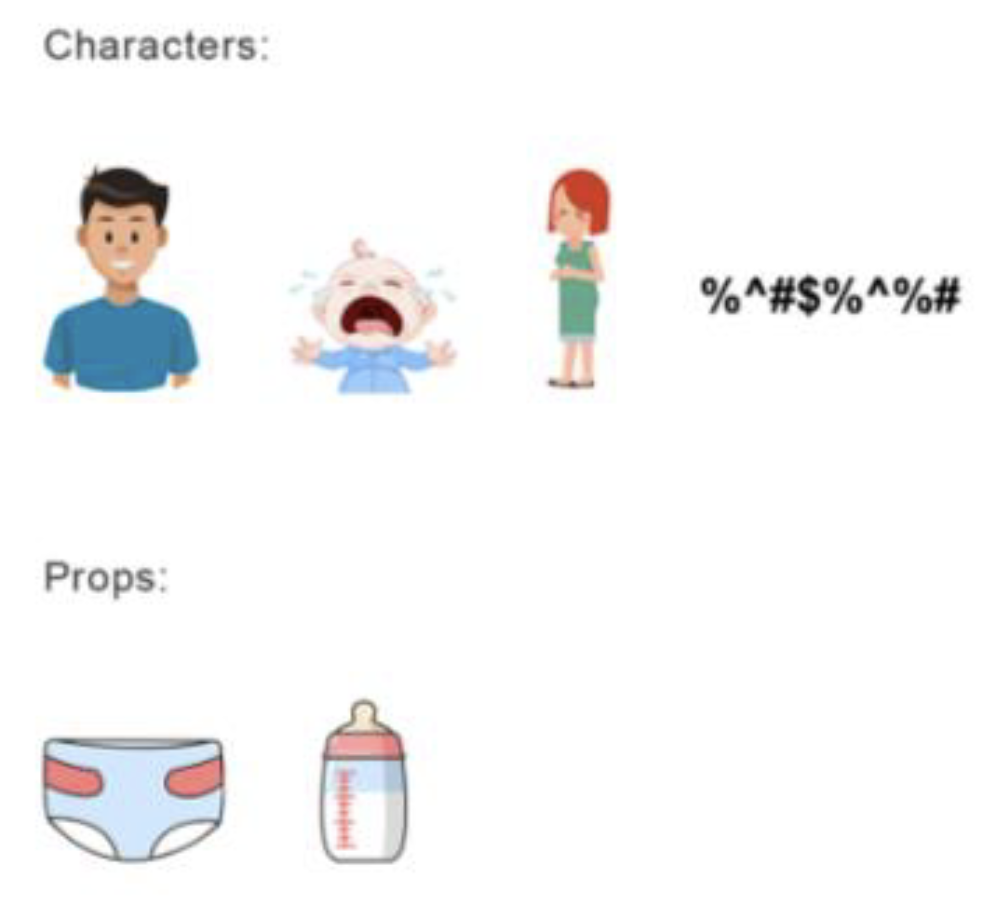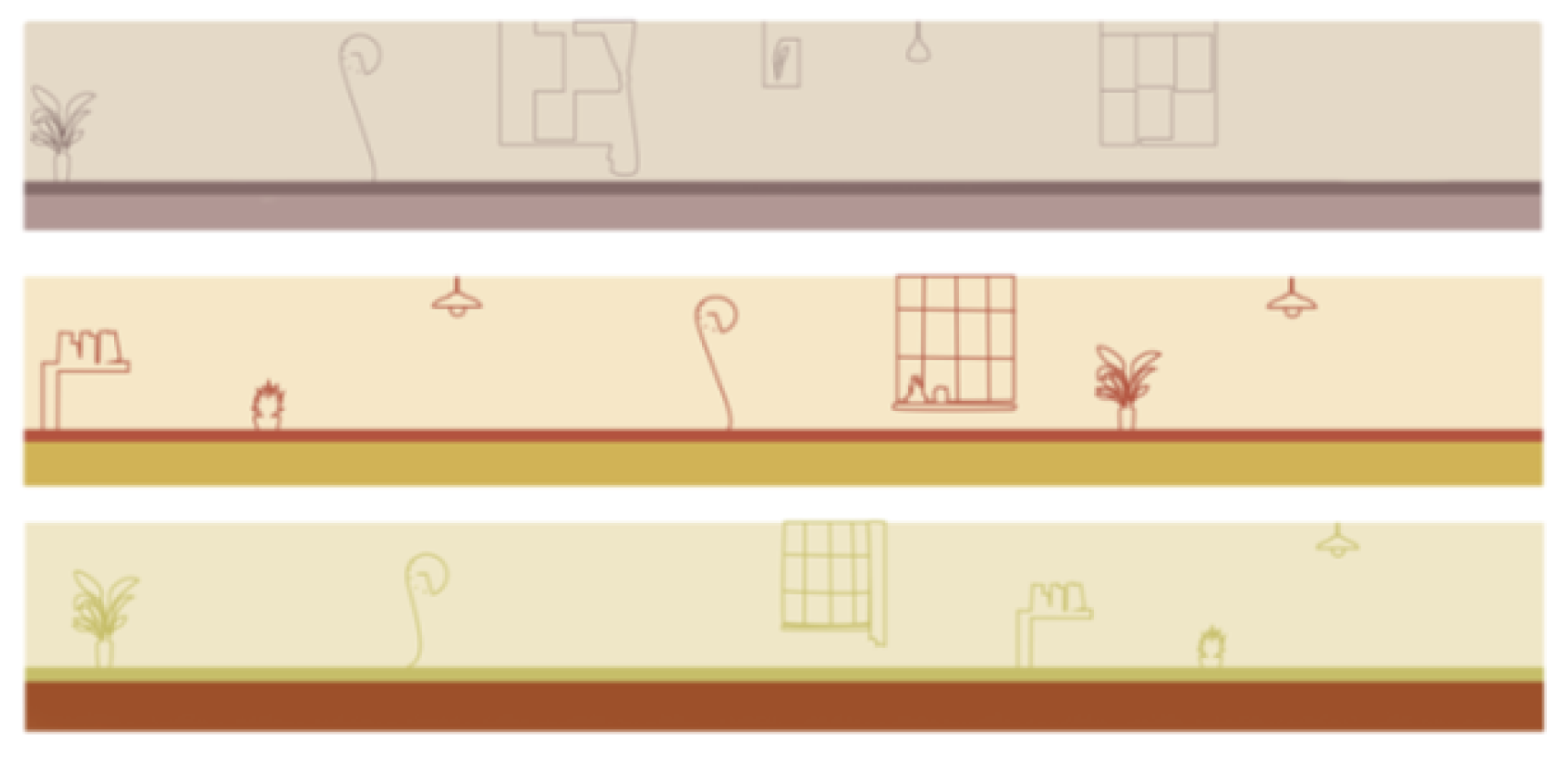Game Design Project
HER ADVENTURE/a game to advocate family support for postpartum depression.
May. 2021
Her Adventure is a 2D platform game that players will play as a new mom to complete several levels by earning scores while keeping the mind level. They must collect bottles and diapers to get scores in order to complete each level, maintain the mind level by avoiding being hurt by the mean words and a fussy baby, and carefully move to avoid falling into depression. They also have limited chances in each level to ask for husband’s help in order to boost their scores. Failing to earn enough scores or keep enough mind level would result in an incomplete level. Falling into depression would lose the game immediately. Momhood is tough, especially when it involves trying not to be depressed. Her Adventure is designed to mimic the postpartum mom hood and advocating for family support.
Link to play the game itch.io: https://arcade.gamesalad.com/games/159746
My Adventure
To
Her Adventure
Before having a kid, there are tons of topics I would like to address by making social impact games. However, after experiencing a depressive postpartum period, I cannot move my attention away from the topic: Postpartum Depression.
Navigating through those days after giving birth to my baby was the biggest challenge in my life. Every pain I heard from news of postpartum depression came to my life, real and personal. In the meantime of conquering the horrible mood of myself, I started to pay more attention to the topic of postpartum mental health.
The efforts, physical practices, nurses and hospital staffs made means a lot to me. Those surveys, telephone interviews and care during the recheck really made me feel helped. The meeting of the support group gave me the strength and power to fight against the difficulties I have as a newbie mom. Most importantly, the support and care from my family members are the key for me to face another new day.
I realized that support, especially those from family members, is the most important to help a new mom navigate through the postpartum period, not only physically healthy, but also mentally.
Therefore, I decided to launch a social media campaign advocating family support of postpartum depression. To better reach out to more young couples, and make the advocacy more acceptable and accessible, I decided to design a game to address the issue.
The Design Process
The design process of Her Adventure is an exploration of game concept.
I had the idea of designing a game to advocate the social issue prior to the actual game design. Below are the concepts I had:
Concept 1: Players will play as a new mom to finish the task(taking care of baby, etc. ) while maintaining a healthy mind level. Finishing tasks will lower the mind level, and game over when they use out of all the mind levels. Husband’s help may help them to earn more scores in a shorter time, however, higher the level, less the help. Since it is a social media campaign, it would be better to launch on a social media platform which involves the ranking of the friends list. Customizing the image of the character could be helpful to make sympathy.
Concept 2: Players will play as a new dad to communicate with his wife. They must make the right choices to maintain the wife’s mind level. The game will be splitted into two screens/views, the husband’s and wife’s. The higher scores players earn, the more colorful the screen will be. Players will have chances to take a look at the wife’s view. Lower the mental level, the less chance to take a look at the wife's view. The mental level will get lower as the game goes if there is no intervention to prevent the wife from dropping into depression. Players will have a clear acknowledgement of whether they are making the right decision by taking the look at the wife’s view.
I got the concept from a game about a veteran’s life after returning to normal life. It shows the reality and the man’s mental world in two screens next to each other. Only one screen is manipulated. The concept is also derived from a movie where the happier the village is, the more colorful the picture is.
Concept 3: Players will play as a new dad to help the wife live without having depression in the postpartum period. They must make decisions for different occasions and earn as many scores as possible. There may be some right answers not selectable since that is how depression works. The game will show how depression feels like to a family member. This concept would be an Affirmative Design from Depression Quest. It also would be a very typical Twine game in which players will explore the story by reading through the text and images and control the ending by making different selections.
After reconsidering all three concepts, I decided to go with concept 1.
The game as the most important part of the social media campaign should be accessible on mobiles and easy to play. As a result, 2D platformers became a good choice to develop and bring all the designs in the concept to life.
Level Design
After deciding to make 2D platformers, I started to design the levels. That is when I felt I was lost.
I have played 2D platformers since I was little, and there are tons of good platformers in the industry. However, I never really paid attention to the level designs of any of them. The levels of 2D platformers are not just some random combination of platforms and enemies. The art of placing each element in the level, balancing the monetary, and designing the proper difficulties is more than interesting but overwhelming to me.
To better understand the key of level design in a 2D platformer, I did the precedent research and tried to learn from other successful 2D platformers how they designed the levels. I read articles of lectures of designing levels, I also watched the video about the designer of Celeste talking about how he designed the game.
Here are the resources I used to learn how to design levels:
Level Design Workshop, Designing Celeste
After understanding the keys to design levels and finding a template of 2D platformers in GameSalad, I started to design my own game.
I used the template developed by: Kenny.nl to get started.
The first version of my level design was completed in Photoshop. Since there are limited lengths in GameSalad window, it is hard to know whether I am placing the platforms and enemies in the proper places. Below are the level designs first version:
Although I thought I had learnt how other designers who are really good design the levels, the fact still gave me a strike in the face saying: “Nope, it’s not working.”
After testing in the GameSalad, I found there are platforms that are not reachable while some of the enemies are unavoidable.
The result is I have to adjust all the elements in the level by testing it again and again by myself.
I adjusted the game not only by moving things around, but also added more features to control the difficulties. At the very beginning, there were only platforms and enemies. After many refinements, there are crying babies that would decrease the mind level, helping husbands that would boost the scores and depression at the bottom to over the game. Here are the final level designs:
Since I have played so many times, I was so good at this game. I found almost all my players complained it was too hard when it comes to the playtesting. This was not expected, and I started to adjust the difficulty of each level by watching over and over how my playtesters played the game.
Although I changed the difficulty, I still kept the game to be intense. The original idea of this game is to promote the idea of providing support to new moms who are having extremely difficult postpartum stage. The design is meant to make players feel hard by forcing them to understand the necessity of family support. As a result I kept the game at a hard level, and made the last level almost not possible to accomplish.
Development Log
1. Start from the template
2. Change the assets to own arts
3. Create pixel arts
4. Start to change the functions
5. Rules
6. Story
7. Level Design
8. Music
9. Power Up Feature – Husband’s Help
Please feel free to check out the Full Development Log
The Arts And The Assets
The arts are designed along with the game design. I had a rough idea of what tone the game’s art would be at the very early stages of level design.
Instead of what I use right now, I was thinking about the scenario of the character having adventure in a home set. The color would be lower saturated, warm and cozy. The images would be cartoonish and cute.
I made the first version of the background and characters for the game long before the playtesting, which gives me plenty of time to make changes. The result was not as satisfying as I thought.
The furniture and decorations on the wall in the background makes the interactive items less popped up. In addition, the whole game looks overwhelming. To make the interactive objects more visible, I changed the background:
Although the visual was doing a better job with the new background, the art style is still unsatisfying enough. Since 2D platformers are a classic type of game, I tried to turn the art into pixelated style. This brought better game visions compared to the previous style and brought everything together.
Here’s the final art:
For the sounds and musics, I found them on youtube free sources.
I used 8-bit music to match the pixelated feeling with the arts.
I also found some sound like baby crying, power up, exploding sound to enhance the play experience. Some of the sound effects are come from the template.
Here are the music and sounds I use:
1) Yoshi’s Island Map
2) Illusion of the time – Itory, the hidden village
3) Reset music
4) EVO Searching for eden – sad theme
5) Chrono Trigger – Battle Scene
6) Crying Baby Sound Effect
Post-Mortem
The experience of developing Her Adventure was really impressive to me in terms of the concept design, level design and art design.
I implemented many game design theories in the process of making this game, design methodologies, game rhetorics, ect.. It was also a decent experience of developing a game from scratch.
What the most important skill I learnt from this process was how to do the level design. I am aware that the level design in this game is not close to perfect. However, the experience of learning and practicing what I learnt from other awesome designers is the most significant lecture in the progress.
The level design was so complicated to me at the very beginning. There are too many things to consider to design a good level. However, it was so charming that the deeper I learnt, the more interesting it became. The balancing of the monetary and the art of putting each item in the proper places really caught my interest. It was super fun to design the levels, and I am willing to do more design like this in the future.
This experience also strengthened my passion for making social impact games. I believe that games can not only be fun, but also a more effective way to communicate ideas.
One thing for sure is that I would explore the potential of games in terms of communicating with people about issues that are worthy to discuss.
It all begins with an idea. Maybe you want to launch a business. Maybe you want to turn a hobby into something more. Or maybe you have a creative project to share with the world. Whatever it is, the way you tell your story online can make all the difference.
Don’t worry about sounding professional. Sound like you. There are over 1.5 billion websites out there, but your story is what’s going to separate this one from the rest. If you read the words back and don’t hear your own voice in your head, that’s a good sign you still have more work to do.






